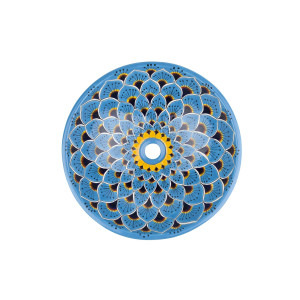Jardinera - richly decorated flower bed from Mexico
- Dimensions: length 31 cm x width 13 cm
- Hand-made and decorated by Mexican artists.
- Lively colors, carefully made ornaments
- Fast shipping from Poland
- Safe packaging
Ceramic pot Jardinera
Ceramic pot made in Mexico with dimensions of about 31 cm long, about 13 cm wide. Pot made by Talaver method. The thick layer of dye, glazing and firing method gives the ceramics a 3D effect. Manual creation of the pot makes the edges irregular.
The pot is decorated with floral patterns in very popular for Mexican ceramics shades of yellow, green, blue, red and black. The pot has two holes in the bottom to drain water.
Telavera ceramics
The production method of Telaver was brought to Mexico by Spanish colonizers. They brought production methods from the village of Talavera de la Reina, where such methods of producing ceramics were initiated. The designs and colors themselves refer to the Mayan and Aztec cultures.
Manual production of Mexican pottery is characterized by a variety of patterns and decorations. It can be assumed that each product is a work of art without a copy. Due to their diversity and quality of workmanship, Telavera's products are becoming increasingly popular also in Europe.
Talavera decorations
Decorative elements made of ceramics are very popular everyday objects in Mexico. Colorful pots, figures, sunshine, animals, cups and mugs refer with patterns to tradition and religion. Colors, which are decorated with decorations often harmonize with outdoor space, sun, water, vegetation. Ceramics in the form of tiles are almost a permanent feature of every house in Mexico. Faience declarations are ideally suited to single-color tiles or patchwork compositions and are often the dominant decorative element of a room. The way Mexican ceramics are made allows to expose the decoration also outside, on terraces, balconies and gardens. Designers who place Mexican ceramic decorations in their works claim that they do not like loneliness, they best fit into the environment when there are several. This means that their presence is not accidental and the effect is intended.
Ceramic pot made in Mexico with dimensions of about 31 cm long, about 13 cm wide. Pot made by Talaver method. The thick layer of dye, glazing and firing method gives the ceramics a 3D effect. Manual creation of the pot makes the edges irregular.
The pot is decorated with floral patterns in very popular for Mexican ceramics shades of yellow, green, blue, red and black. The pot has two holes in the bottom to drain water.
Telavera ceramics
The production method of Telaver was brought to Mexico by Spanish colonizers. They brought production methods from the village of Talavera de la Reina, where such methods of producing ceramics were initiated. The designs and colors themselves refer to the Mayan and Aztec cultures.
Manual production of Mexican pottery is characterized by a variety of patterns and decorations. It can be assumed that each product is a work of art without a copy. Due to their diversity and quality of workmanship, Telavera's products are becoming increasingly popular also in Europe.
Talavera decorations
Decorative elements made of ceramics are very popular everyday objects in Mexico. Colorful pots, figures, sunshine, animals, cups and mugs refer with patterns to tradition and religion. Colors, which are decorated with decorations often harmonize with outdoor space, sun, water, vegetation. Ceramics in the form of tiles are almost a permanent feature of every house in Mexico. Faience declarations are ideally suited to single-color tiles or patchwork compositions and are often the dominant decorative element of a room. The way Mexican ceramics are made allows to expose the decoration also outside, on terraces, balconies and gardens. Designers who place Mexican ceramic decorations in their works claim that they do not like loneliness, they best fit into the environment when there are several. This means that their presence is not accidental and the effect is intended.
Product Details
- Product code: D02
- Manufacturer: Cerames
- Colour Multicolor
- Material Ceramic
- Application Inside
- Country of origin Mexico
You might also like
€364.00




















